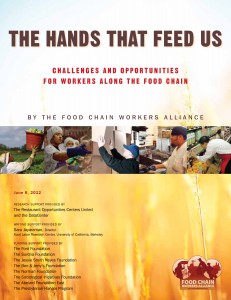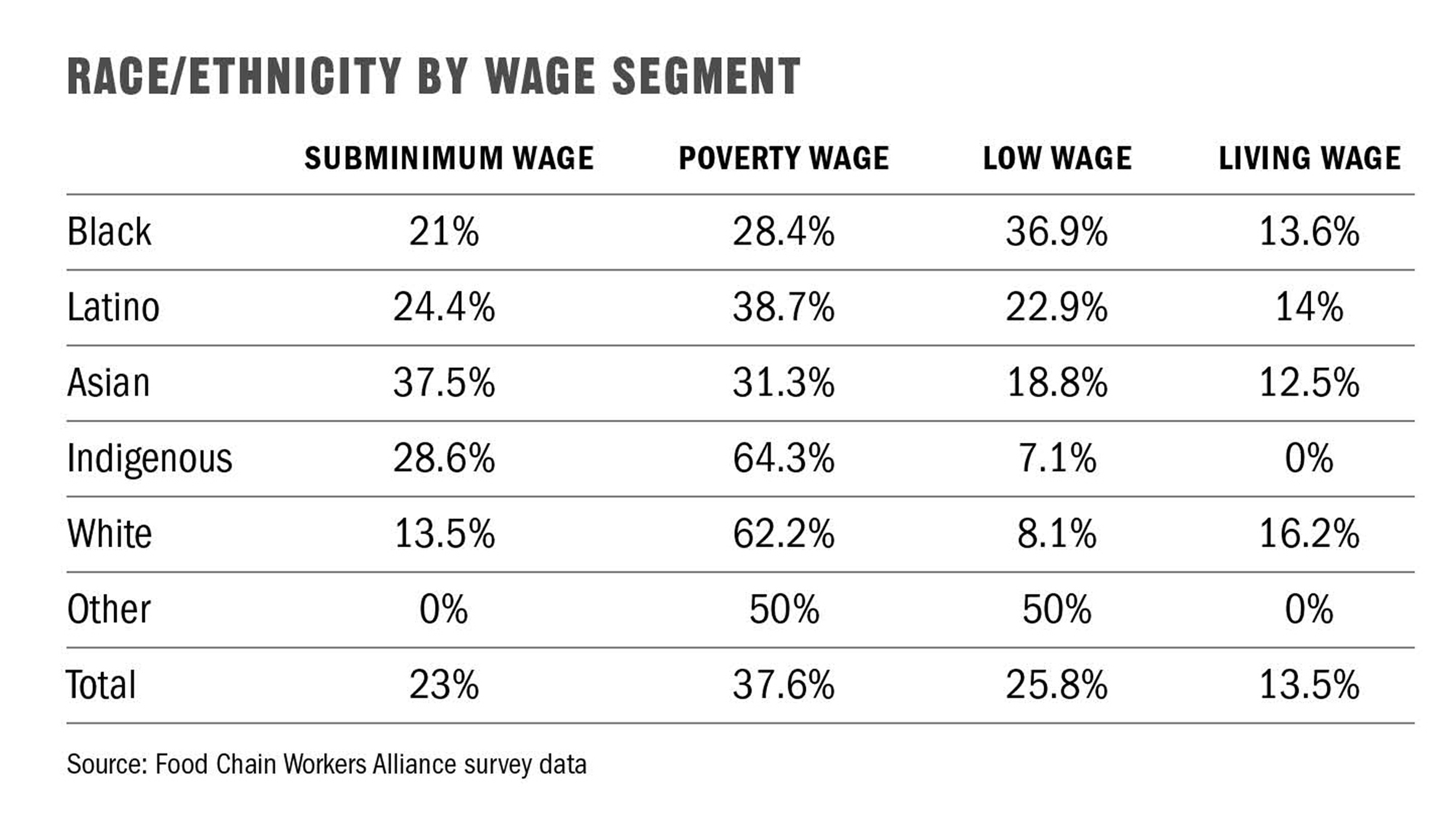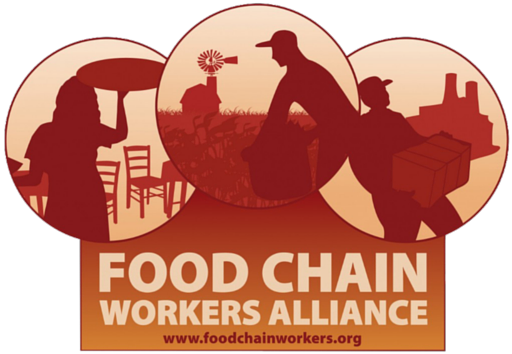 June 6, 2012 – Today, the Food Chain Workers Alliance releases a new report, The Hands That Feed Us: Challenges and Opportunities for Workers Along the Food Chain, the first of its kind that looks at wages and working conditions of workers across the entire food chain – a sector that employs 20 million people in the U.S., comprising one-sixth of the nation’s workforce.
June 6, 2012 – Today, the Food Chain Workers Alliance releases a new report, The Hands That Feed Us: Challenges and Opportunities for Workers Along the Food Chain, the first of its kind that looks at wages and working conditions of workers across the entire food chain – a sector that employs 20 million people in the U.S., comprising one-sixth of the nation’s workforce.
The Hands That Feed Us is based on nearly 700 surveys and interviews with workers and employers in food production, processing, distribution, retail and service, which collectively sell over $1.8 trillion dollars in goods and services annually, accounting for over 13 percent of the nation’s Gross Domestic Product.
According to our report, there are some good jobs in the food system (13.5% of workers surveyed earn livable wages), but the vast majority are incredibly low-wage, with little or no access to paid sick days and health benefits, with dire  consequences for consumers. More than 86 percent of workers reported earning subminimum, poverty, and low wages, resulting in a sad irony: food workers face higher levels of food insecurity, or the inability to afford to eat, than the rest of the U.S. workforce.
consequences for consumers. More than 86 percent of workers reported earning subminimum, poverty, and low wages, resulting in a sad irony: food workers face higher levels of food insecurity, or the inability to afford to eat, than the rest of the U.S. workforce.
You can download the full report, the executive summary, and the executive summary in Spanish. If you would like a hard copy of any of these, please contact us at info (at) foodchainworkers.org.
The Hands That Feed Us examines the five core food occupations and industries in the food system: farmworkers (production), slaughterhouse and other processing facilities workers (processing), warehouse workers (distribution), grocery store workers (retail), and restaurant and food service workers (service). It examines how corporate consolidation throughout the food chain has created universal impacts on workers in terms of low wages, small to midsize employers in terms of unfair competition, and consumers in terms of food quality and diversity. Employers interviewed unanimously commented on how multinational food corporations receiving government subsidies and tax breaks and buying up their own suppliers has created unfair and unmanageable competition.
In addition to examples of poor work environments, the report also highlights fair business practices and steps that policymakers, consumers, and employers can take to improve conditions for food system workers.
Key Findings from The Hands That Feed Us:
Lack of Benefits: Seventy-nine percent of food system workers do not have a single paid sick day, or do not know if they have paid sick days, and 58 percent lack health coverage. Consequently, 53 percent have admitted to working while sick.
 Reliance on Public Support: Food system workers use food stamps at one-and-a-half times the rate of the rest of the U.S. workforce. Food industry employees are also more likely receive Medicaid than other industries. Nearly 28% of food system employees are on Medicaid, compared to 19.36% of all industries. Due to a lack of employer-provided health benefits, more than one third of all workers surveyed (34.8%) report using the emergency room for primary health care. In addition, 80 percent of these workers are unable to pay for such care.
Reliance on Public Support: Food system workers use food stamps at one-and-a-half times the rate of the rest of the U.S. workforce. Food industry employees are also more likely receive Medicaid than other industries. Nearly 28% of food system employees are on Medicaid, compared to 19.36% of all industries. Due to a lack of employer-provided health benefits, more than one third of all workers surveyed (34.8%) report using the emergency room for primary health care. In addition, 80 percent of these workers are unable to pay for such care.
Poor Quality of Life: A full 10 percent reported working more than 10 hours per day, and the vast majority of those reported working 60 or more hours per week. Almost half of the workers also reported working multiple jobs to make ends meet.
Lack of Upward Mobility: Despite taking on more duties, 81 percent never received a promotion.
Improper Safety Training: More than half of all workers surveyed (52 percent) reported that they did not receive health and safety training from their employers. Almost one-third of all food system workers (32.7%) reported that their employers did not always provide necessary equipment to do their jobs. A majority of workers (57.2%) reported suffering an injury or illness on the job.
 Gender and Race Discrimination: While about one quarter of Black and Latino workers and almost 40 percent of Asian workers reported earning less than the minimum wage, only 13.5 percent of white workers surveyed reported earning less than the minimum wage. Not surprisingly given these differences, more than one third of workers surveyed reported feeling that they had been discriminated against by their employer. Women food system workers take home slightly less than men in the food system; women earn median weekly wages of $400, while men reported a median weekly take-home of $421.
Gender and Race Discrimination: While about one quarter of Black and Latino workers and almost 40 percent of Asian workers reported earning less than the minimum wage, only 13.5 percent of white workers surveyed reported earning less than the minimum wage. Not surprisingly given these differences, more than one third of workers surveyed reported feeling that they had been discriminated against by their employer. Women food system workers take home slightly less than men in the food system; women earn median weekly wages of $400, while men reported a median weekly take-home of $421.
There are answers: There is tremendous potential to engage consumers, small-to-midsize employers and workers to change the food system for all. For starters policymakers can increase the minimum wage and guarantee workers health benefits and the right to organize. Consumers can support businesses that are providing livable wages and benefits, and speak out against those that are not. Employers can increase wages and benefits; adopt systematic and fair hiring and promotion practices; and adopt benefits, such as paid sick days, that would allow employees to care for themselves and their families.
Read The Hands That Feed Us for more detailed recommendations for policymakers, consumers, and employers!
Help us connect with consumers! Take our GoodMaker Challenge and submit an idea for a creative way to educate consumers! Click here for more info!
Check out the media coverage of the report! Click here for the full list!
Research support for the report was provided by the DataCenter and the Restaurant Opportunities Centers United. Writing support was provided by Saru Jayaraman, director of the Food Labor Research Center, University of California, Berkeley.

80 Comments